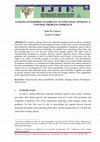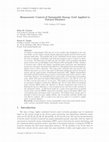Papers by Fernando Yanine
Research Square (Research Square), Jan 29, 2024
2021 IEEE 22nd Workshop on Control and Modelling of Power Electronics (COMPEL), 2021
Existing power systems are both weak and vulnerable when it comes to environmental threats, wheth... more Existing power systems are both weak and vulnerable when it comes to environmental threats, whether these occur due to natural disasters like earthquakes and hurricanes or extreme weather phenomena like torrential rains and hail. Under these circumstances, urban and rural communities are continuously evolving towards more self-balanced, self-sustainable electrical arrangements. This paper gives a brief overview of the existing energy community models, the technologies involved, and the services, along with some background in order to illustrate how these come about and what the conditions and requirements are to advance such initiatives, from both the private and the public sectors.

2013 International Renewable and Sustainable Energy Conference (IRSEC), 2013
ABSTRACT We explore supervisory control strategies for the operation of grid-connected hybrid ene... more ABSTRACT We explore supervisory control strategies for the operation of grid-connected hybrid energy systems (HES) as complex adaptive systems. We do this not from a demand response management standpoint, like most of the literature does, but from a power generation and supply viewpoint, by means of homeostatic regulation and control with an aim for sustainable micro-generation systems for small-size communities. Homeostatic control (HC) is a term introduced by Fred C. Schweppe and his group of collaborators at MIT back in 1979 and early 1980s and stems from the highly visionary work done by them. We build on this concept and take a new approach, presenting our model and simulation results, which show clearly how HC and regulation of energy intake and expenditure by consumers, along with the presence of energy storage and compensatory mechanisms in the microgrid can provide much insight on how to make these systems more efficient, sustainable and resilient, particularly when integrated to the mains. Simulation provides a good fit to the data, and the response of the system to changing supply in different scenarios was characterized by its consistency and logical framework, supporting the model employed.
Procedia Computer Science, 2022
2023 9th International Conference on Electrical Energy Systems (ICEES)

Iberoamerican Journal of Industrial Engineering, 2013
In order to operate effectively, industrial enterprises must be able to coordinate and utilize th... more In order to operate effectively, industrial enterprises must be able to coordinate and utilize their limited physical and managerial resources effectively to deal with uncertainty and complexity, following certain strategic options and guidelines. Enterprises must be able to acknowledge the tensions between flexibility and stability forces operating within them, and then manage them in a way that best reflects their strategic options. This paper looks at manufacturing enterprises as complex dynamic systems operating under certain strategic guidelines and constraints in order to be both effective and efficient. At the same time, they ought to be stable yet flexible enough to be able to deal effectively with perturbations, generated both within and outside of the system. In this higher level control problem approach to enterprise flexibility it is examined how both properties: flexibility and stability depend on the meta-controllability of the enterprise system. That is the control over the enterprise control system, the role of management in the meta-controllability of the enterprise, and how these control actions, which determine when, where and how much flexibility is applied, are linked to specific strategic needs and objectives that reflect the strategic options of the organization at the operational, business, and corporate level respectively.
Procedia Computer Science

Journal of Enterprise Information Management, Oct 10, 2016
Purpose The purpose of this paper is to draw attention to a void in the literature on enterprise ... more Purpose The purpose of this paper is to draw attention to a void in the literature on enterprise flexibility: The Management Control Systems’ (MCS) role in the enterprise flexibility and stability discussion. MCS can be instrumental in securing an organization’s strategic performance objectives, far beyond the mere managerial control and accounting perspectives of traditional MCS’ roles. Design/methodology/approach This study is qualitative in nature, and presents a theoretical approach with a conceptual model to address enterprise flexibility and stability jointly; arguing that both should be part of the MCS’ design and implementation with a distinct strategic outlook. Several theoretical and practical arguments are presented which reinforce this thesis. Findings To operate optimally, enterprises must be able to manage their limited resources in efficient and effective manner. This is especially so when dealing with uncertainty and contingencies on an ongoing basis, while following a defined strategic choice. Such choices are expected to mirror enterprise flexibility types and measures without neglecting enterprise stability requirements, linking both to strategic performance measurement indicators. Research limitations/implications Further work is needed to explore not only how different types of enterprise flexibility and stability measures can bring additional benefits to the firm but also how best to apply such types in accordance with business and operations strategies, organizational stability requirements and management control strategies. Practical implications MCS can and should take part of an organization’s strategic performance measures but these are to be understood from a systemic design perspective of the enterprise system’s metacontrollability, addressing flexibility and stability jointly. Social implications There is a need to reevaluate the role of MCS and their strategic potential. The approach presented can have valuable potential ramifications and insights for management and information sciences as well as for the enterprise management practitioners as a whole. Originality/value This paper provides original research on enterprise flexibility and stability analysis, covering all aspects of MC and its role on the enterprise’s metacontrollability. Design and coordination of the seven basic elements which comprise MCS are analyzed, as well as how they influence one another. The paper includes two tables to illustrate the approach being proposed. Table I presents a classification of the literature reviewed in the paper while Table AI presents the choice of the theoretical lens on enterprise flexibility from other authors which contrasts with the model proposed. The role of MCS in the enterprise is also included.
Procedia Computer Science

Elsevier eBooks, 2021
Abstract Today’s power generation and distribution industry is being faced with a number of issue... more Abstract Today’s power generation and distribution industry is being faced with a number of issues, from violent weather phenomena to earthquakes, fires, and landslides; including acts of arson, terrorism, and vandalism, all of which pose serious concerns for the sustainability of the distribution and supply of electricity. Electric utilities like ENEL are cognizant of this fact and know they must take action. Moreover, they are required by law to be prepared and act proactively to prevent service disruption, by responding to such challenges rapidly and effectively so as to preserve stability and continuity of operation. Homeostaticity of energy systems seeks just that: to bring about a rapid, effective, and efficient state of equilibrium between energy supply and expenditure at all times, whatever the circumstances, to preserve stability of systems operation. The chapter presents a prescriptive energy homeostaticity model being considered by ENEL as a means to further the incorporation of renewables in the electricity generation and distribution industry. The aim is to enhance control and energy management systems in distributed generation installations tied to the grid for urban and rural communities, in order to complement and diversify their electric power distribution services. The theoretical groundwork underlying the subject as well as other relevant contextual factors are also discussed and simulation results are presented under different tariff scenarios, and energy storage alternatives, in order to compare the proposed model with the actual case. Energy storage (ES) is found to be of paramount importance in the overall analysis of the results as it enhances and reinforces thriftiness on energy consumption.

2021 Innovations in Power and Advanced Computing Technologies (i-PACT), 2021
The study looks at a hybrid control approach for an islanded solar low voltage photovoltaic-based... more The study looks at a hybrid control approach for an islanded solar low voltage photovoltaic-based dc microgrid, with the goal of overcoming the limitations of both centralized and distributed control schemes. A Photo Volatile system with battery storage is used on bus 1, battery storage with supercapacitor is used on bus 2, and variable loads like automobile applications are used on bus 3. The suggested hybrid control approach is capable of effortlessly transitioning between high and low bandwidth communication to construct a distributed control system in the event of a central failure. The central supervisory control system is in responsible of adjusting grid settings as well as sending and receiving data to and from local node controllers, that govern bus voltage and energy management. The study demonstrates how system transients are absorbed using battery and supercapacitor devices during load changes. The simulation depicts the continuous flow of information and decision-making processes via each level of control while taking subsystem restrictions into consideration.

2020 International Conference on Renewable Energy Integration into Smart Grids: A Multidisciplinary Approach to Technology Modelling and Simulation (ICREISG), 2020
Sensor is an electronic module whose purpose is to measure the parameters of the system and send ... more Sensor is an electronic module whose purpose is to measure the parameters of the system and send those details to the control station. Sensor plays an important role in many applications to ensure the successful operation of the system. The main objective of this paper is to summarize the application of sensors and its characteristic features in various stages of solar power generation system and also the implementation of voltage and current sensors in real time. To evaluate the performance of voltage and current sensor in real time the experimental setup of Boost Converter has been developed in the laboratory for Photovoltaic (PV) application by using Maximum Power Point Tracking (MPPT) techniques through the dSPACE DS1103 Rapid control prototype interface. It is envisioned that the information provided in this paper to serve as a valuable reference for future research in sensor application.

International Journal of Computers Communications & Control, 2012
According to seismologists Chile has yet to face another big earthquake in the very near future, ... more According to seismologists Chile has yet to face another big earthquake in the very near future, yet the country remains largely unprepared against massive electric power systems brake-down. The problem lies in the centralized electric power systems and the lack of adequate technologies and back-up/emergency power systems for disaster recovery. The flaws that are built into the very fabric of the presently centralized power systems were on full display in the February 27th earthquake in Chile. Nowhere it becomes more evident that hugely centralized power generation and distribution systems are extremely vulnerable and ineffective to disruptions from natural disasters, human error or other calamities. The large power networks that once proved very efficient and secure, are now at the center of discussion fueling the need for decentralization and the rapid growth of distributed generation (DG). Highly decentralized, diversified and DG-oriented energy matrix is notoriously much better suited to withstand these disasters. In centralized electric power grids, servicing large metropolitan areas, albeit with some but limited differentiation in service, can only be on or off, so either everyone gets power or no one does. This makes recovering power service in an emergency situation a much more difficult task. On the other hand, decentralized power systems (DPS) reduce the obstacles to disaster preparation and recovery by allowing the focus to shift first to critical infrastructure and then to flow outward to less integrated outlets. A DG-based model for a smart micro-grid based on hybrid electric power systems (HEPS) using both renewable energy technologies (RET) and conventional power generation units is presented. The hybrid energy system may be portable or fixed in one place, highly reliable, easy to assemble, modular, flexible and cost-effective solution, that is ready-to-run and go to where it is needed to supply power in natural disaster.

2021 Innovations in Power and Advanced Computing Technologies (i-PACT), 2021
India has an enormous potential of solar energy due to its geographical position and therefore se... more India has an enormous potential of solar energy due to its geographical position and therefore several initiatives were taken by the Government of India (GoI) for maximizing the utilization of the green energy. Recently Ministry of New and Renewable Energy (MNRE) had started Pradhan Mantri Kisan Urja Suraksha evem Utthan Mahabhiyan (PM KUSUM) scheme for the solarisation of grid connected agricultural pumps. The objective of this scheme is to add about 25GW of solar energy by 2022. A novel low cost, microcontroller less irrigation system is proposed in this paper which can be useful for such solarized grid-connected irrigation system and can reduce the energy and water wastage considerably. In this proposed system, the switching operation is performed according to soil moisture content, Photo-Voltaic (PV) generation availability and electricity grid voltage conditions by using a low cost, dedicated electronic circuitry and thereby eliminating the need of any microcontroller.
Procedia Computer Science

Today’s power generation and distribution industry is being faced with a number of issues, from v... more Today’s power generation and distribution industry is being faced with a number of issues, from violent weather phenomena to earthquakes, fires, and landslides; including acts of arson, terrorism, and vandalism, all of which pose serious concerns for the sustainability of the distribution and supply of electricity. Electric utilities like ENEL are cognizant of this fact and know they must take action. Moreover, they are required by law to be prepared and act proactively to prevent service disruption, by responding to such challenges rapidly and effectively so as to preserve stability and continuity of operation. Homeostaticity of energy systems seeks just that: to bring about a rapid, effective, and efficient state of equilibrium between energy supply and expenditure at all times, whatever the circumstances, to preserve stability of systems operation. The chapter presents a prescriptive energy homeostaticity model being considered by ENEL as a means to further the incorporation of r...

modern society, driving business performance management (BPM) in sustainable companies keen on em... more modern society, driving business performance management (BPM) in sustainable companies keen on embracing greater social equity and business fairness. This process entails a paradigm shift which is particularly noticeable in a large sector of the business community in Latin America, and particularly in Chile: the SMEs, which unlike big corporations, don’t have the financial strength to play the political game. First, this paper outlines and discusses the emerging reality of an increasingly greater number of Chilean companies in this category which exhibit distinctive traits and strategic options that support and give credence to this growing trend. Second the paper establishes a set of principles and guidelines that characterize such companies drawing from actual experience and results obtained. As a result, a theoretical framework is built which gathers distinct business practices and management styles that constitute an increasingly visible trend in this sector. The business and so...











Uploads
Papers by Fernando Yanine